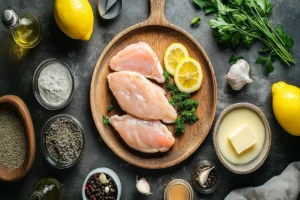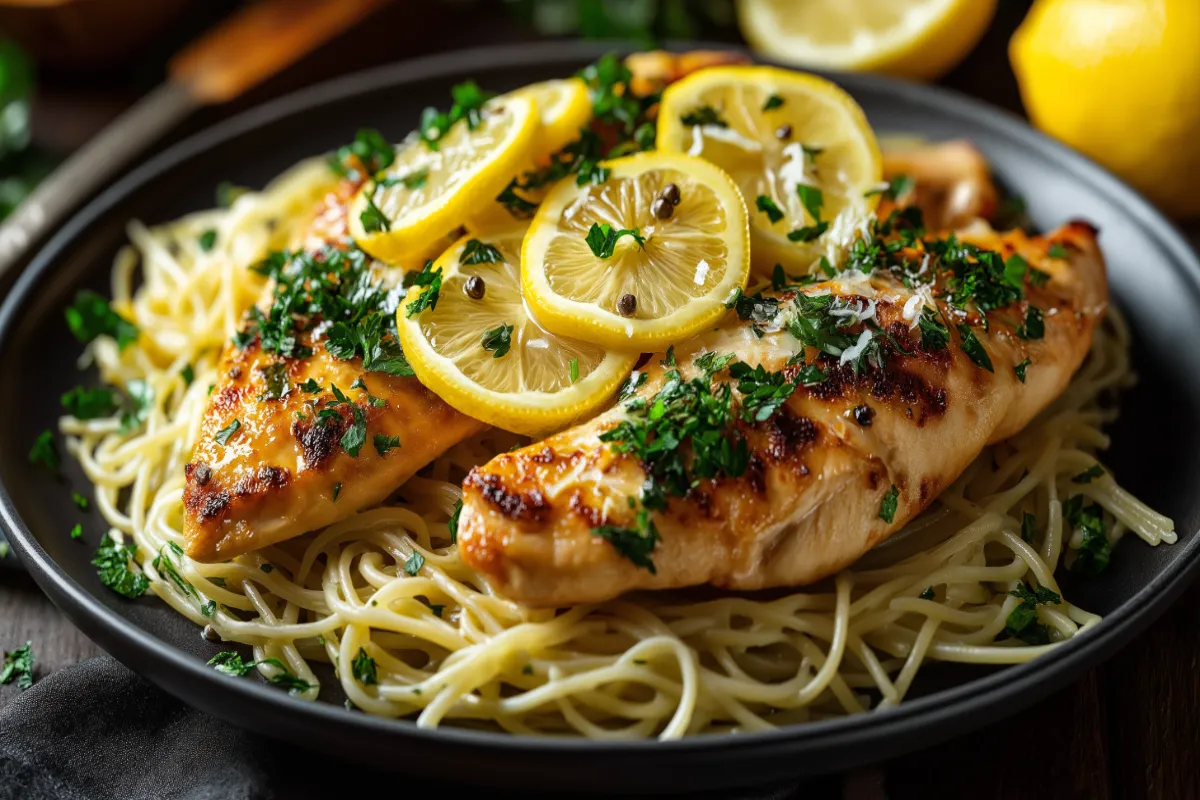Chicken piccata is a timeless, elegant dish that blends vibrant, tangy flavors with a hint of richness from butter and olive oil. A staple of Italian-American cuisine, it’s a simple yet impressive meal that can elevate any occasion. The core elements include lightly fried chicken cutlets smothered in a lemon-caper sauce, delivering a delightful combination of acidity and saltiness. Whether served with pasta, rice, or vegetables, piccata is a versatile dish that suits both casual weeknight dinners and special occasions alike.
In this guide, we’ll cover everything you need to know about chicken piccata, including its history, key ingredients, and step-by-step instructions for preparing a flawless dish. We’ll also explore different variations and provide some expert tips to make sure your piccata turns out perfectly every time. By the end, you’ll be ready to cook a meal that’s sure to become a family favorite.
The Origins of Piccata
The origins of piccata can be traced back to Italy, where the dish was originally prepared using veal. Known as veal piccata, it was a common way to prepare tender cuts of veal, using lemon, butter, and capers to create a bright, tangy sauce that offset the richness of the meat. However, as Italian immigrants brought the recipe to the United States, chicken gradually replaced veal as the protein of choice due to its accessibility and affordability.
While the dish retains its Italian roots, chicken piccata has become a signature part of Italian-American cuisine. For a deeper dive into the cultural evolution of dishes like this one, check out this guide on Italian-American cuisine.
What Exactly is Chicken Piccata?
At its core, chicken piccata is all about balance. The tartness of the lemon and the brininess of the capers are mellowed by the richness of butter and the mild flavor of the chicken. The simplicity of the dish allows the high-quality ingredients to shine, making it a favorite for those who appreciate bold yet straightforward flavors.
It’s also a highly adaptable dish. While chicken is most commonly used, you can easily substitute other proteins or even vegetables for a vegetarian take. Regardless of the variation, the key elements remain the same: a tangy sauce, a well-cooked protein, and a few aromatics to bring everything together.
For those looking to balance their meal with something sweet, you may enjoy serving piccata alongside a dessert like this red velvet brownies recipe, which combines a rich chocolate flavor with a hint of tang from the cream cheese frosting.
Essential Ingredients for Chicken Piccata
To make the perfect chicken piccata, you’ll need a few key ingredients that work together to create the dish’s signature flavor profile. Let’s break down the essentials:
- Chicken: Thinly pounded chicken breasts are ideal because they cook quickly and evenly. You can also use chicken thighs if you prefer a richer flavor, but be sure to adjust cooking times accordingly.
- Lemon: Freshly squeezed lemon juice is crucial for the sauce. The acidity from the lemon cuts through the richness of the butter and creates a refreshing contrast. Avoid bottled lemon juice, as it lacks the same brightness.
- Capers: These small, briny buds are the unsung heroes of chicken piccata. Their salty, pickled flavor balances the tartness of the lemon and enhances the overall depth of the dish.
- Butter and Olive Oil: A combination of both fats helps achieve the perfect texture and flavor in the sauce. The olive oil is used for frying the chicken, while the butter enriches the sauce, making it silky and smooth.
- White Wine (Optional): Though optional, white wine is often used in the sauce to add depth and a slight acidity. If you don’t want to use wine, chicken broth is an excellent substitute.
- Garlic and Parsley: While not always included in traditional piccata, these ingredients add freshness and an aromatic quality to the dish.
For those interested in exploring the health benefits of chicken, including how it fits into a balanced diet, this guide on the nutritional benefits of chicken is worth checking out.
Step-by-Step Recipe for Chicken Piccata

Now that we’ve covered the essential ingredients, it’s time to dive into the cooking process. Making chicken piccata is straightforward, and you can have it on the table in under 30 minutes. Follow these steps to create a flavorful and satisfying meal:
1. Prepare the Chicken
- Start by butterflying the chicken breasts to ensure they cook evenly. Place each breast between two sheets of plastic wrap and pound them to about ¼ inch thickness using a meat mallet or rolling pin.
- Season the chicken with salt and pepper, then lightly dredge it in flour. Shake off any excess flour.
2. Pan-Fry the Chicken
- Heat a tablespoon of olive oil and two tablespoons of butter in a large skillet over medium heat. Once the butter has melted and the oil is hot, add the chicken breasts to the pan.
- Cook the chicken for 3-4 minutes on each side, or until golden brown. Once the chicken is cooked through, transfer it to a plate and set it aside.
3. Make the Piccata Sauce
- In the same skillet, add minced garlic (if using) and cook until fragrant, about 30 seconds.
- Deglaze the pan with ½ cup of white wine (or chicken broth), scraping up any browned bits from the bottom of the pan.
- Add ¼ cup of freshly squeezed lemon juice and two tablespoons of capers. Let the sauce reduce for a couple of minutes.
4. Finish the Dish
- Swirl in two more tablespoons of butter to enrich the sauce. Taste and adjust the seasoning as needed.
- Return the chicken to the skillet, allowing it to warm in the sauce for a minute or two.
- Garnish with freshly chopped parsley and serve immediately.
Pairing Suggestions
Chicken piccata is often served with pasta, rice, or vegetables. Here are a few options that complement the dish’s bold flavors:
- Pasta: Serve the chicken piccata over angel hair pasta or spaghetti. The thin strands soak up the lemon-caper sauce beautifully.
- Rice: For a gluten-free option, pair the dish with a light, fluffy rice pilaf.
- Vegetables: Roasted vegetables like asparagus, zucchini, or broccoli make an excellent side dish. The earthy flavors of the vegetables contrast nicely with the brightness of the piccata sauce.
If you enjoy mixing savory and sweet flavors, consider rounding out your meal with something from our dessert collection. A red velvet cookie cake is a fun treat to consider.
Variations of Piccata
While chicken piccata is the most popular version, this dish lends itself well to various adaptations. Whether you’re looking to switch up the protein or explore a plant-based option, there’s a version of piccata for everyone.
1. Veal Piccata
This is the original Italian version of the dish, made with thinly pounded veal cutlets. The preparation is nearly identical to that of chicken piccata, though the flavor is slightly richer due to the veal’s natural fattiness.
2. Fish Piccata
For a lighter, seafood-forward option, fish piccata is a fantastic choice. White fish such as sole, halibut, or cod works well in this recipe. Follow the same process for dredging and frying the fish, but be sure to handle the filets delicately, as they can break apart easily.
3. Vegetarian Piccata
If you’re looking for a meatless option, you can easily adapt this recipe using cauliflower or tofu. For cauliflower, roast the florets in the oven until tender and golden before adding them to the sauce. For tofu, press and slice firm tofu, then pan-fry it until crispy before finishing it in the sauce.
These variations offer a fun twist on the classic dish and are perfect for accommodating different dietary preferences.
Tips for Perfecting Chicken Piccata
While chicken piccata is relatively easy to prepare, a few key tips can help ensure that your dish turns out perfectly every time:
- Use fresh ingredients: Freshly squeezed lemon juice is essential for achieving the bright, tangy flavor that defines this dish. Bottled lemon juice simply won’t have the same effect.
- Don’t overcook the chicken: Because the chicken breasts are pounded thin, they cook quickly. Watch them carefully to ensure they don’t become dry or tough.
- Balance the flavors: Chicken piccata is all about balance. If the sauce is too tart, add a bit more butter or even a small pinch of sugar to mellow out the acidity.
- Serve immediately: The sauce will thicken and lose its silky texture if it sits for too long, so make sure to serve the dish as soon as it’s finished.
Healthier Options for Chicken Piccata
Although chicken piccata is already a relatively light dish, there are a few ways to make it even healthier without sacrificing flavor:
- Reduce the butter: Swap half of the butter for extra olive oil to reduce saturated fat.
- Use gluten-free flour: If you’re gluten-sensitive, simply use gluten-free flour or cornstarch for dredging the chicken.
- Serve with vegetables: Instead of pasta or rice, serve the piccata with a side of steamed or roasted vegetables to keep the dish low-carb and nutrient-dense.
FAQs
What is Piccata Sauce Made Of?
The classic piccata sauce is a simple combination of lemon juice, butter, capers, and, optionally, white wine. These ingredients come together to create a rich, tangy, and slightly salty sauce that perfectly complements the chicken.
Can I Make Chicken Piccata Without Wine?
Absolutely! If you’d prefer not to use wine, you can substitute chicken broth or even water. While the flavor will be slightly different, the dish will still be delicious and tangy.
How Does Chicken Piccata Differ from Chicken Marsala?
While both dishes are Italian in origin, piccata and marsala differ in their sauces. Chicken piccata features a lemon-caper sauce, while marsala is made with a rich, sweet sauce made from marsala wine and mushrooms.
Can I Freeze Chicken Piccata?
Yes, you can freeze chicken piccata, but it’s best to freeze the chicken and sauce separately. When you’re ready to eat, reheat the chicken and make a fresh batch of sauce to pour over it for the best flavor and texture.
Final Thoughts
Chicken piccata is a delightful and versatile dish that’s easy to prepare and impressive to serve. Whether you stick to the classic recipe or try one of the many variations, this meal is sure to become a favorite in your kitchen. By following the steps outlined in this guide, you can create a restaurant-quality dish that your family and friends will love.
Be sure to explore more from our collection of recipes, such as the perfect breakfast pizza, to round out your culinary repertoire. Happy cooking!

